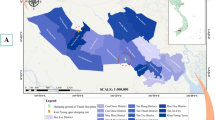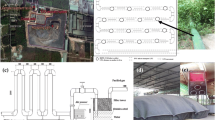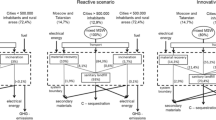Abstract
Measurements of landfill methane emission were performed at nine solid waste disposal sites in Thailand, including five managed sanitary landfills (four deep and one shallow landfills) and four unmanaged landfills (three deep and one shallow dumpsites). It was found that methane emissions during the rainy season were about five to six times higher than those during the winter and summer seasons in the case of managed landfills and two to five times higher in the case of unmanaged landfills. Methane emission estimate using the Intergovernmental Panel on Climate Change (IPCC) Waste Model was compared with the actual field measurement from the studied disposal sites with methane correction factors and methane oxidation factors that were obtained by error function analysis with default values of half-life parameters. The methane emissions from the first-order decay model from the IPCC Waste Model yielded fair results compared to field measurements. The best fitting values of methane correction factor were 0.65, 0.20, 0.15, and 0.1 for deep landfills, shallow landfills, deep dumpsites, and shallow dumpsites, respectively. Using these key parameters in the case of Thailand, it was estimated that 89.22 Gg of methane were released from solid waste disposal sites into the atmosphere in 2006.
Similar content being viewed by others
References
Barlaz, M., Ham, R., & Schaefer, D. (1990). Methane production from municipal refuse: A review of enhancement techniques and microbial dynamic. Critical Reviews in Environmental Control, 19, 557–584.
Bogner, J., Meadows, M., & Czepiel, P. (1997). Fluxes of methane between landfills and the atmosphere: Natural and engineered controls. Soil Use and Management, 13, 268–277. doi:10.1111/j.1475-2743.1997.tb00598.x.
Chiemchaisri, C., Juanga, J. P., & Visvanathan, C. (2007). Municipal solid waste management in Thailand and disposal emission inventory. Environmental Monitoring and Assessment, 135, 13–20. doi:10.1007/s10661-007-9707-1.
Chomsurin, C. (1997). Evaluation of gas migration and methane oxidation in domestic solid waste landfill. Master’s thesis, Asian Institute of Technology.
Cossu, R., Andreottola, G., & Muntoni, A. (1996). Modelling landfilling gas production. In T. H. Christensen, R. Cossu, & R. Stegmann (Eds.), Landfilling of waste: Biogas (pp. 237–268). London: E&FN Spon.
Forster, P., Ramaswamy, V., Artaxo, P., Berntsen, T., Betts, R., Fahey, D. W., et al. (2007). Changes in atmospheric constituents and in radiative forcing. In S. Solomon, D. Qin, M. Manning, Z. Chen, M. Marquis, K. B. Averyt, M. Tignor, & H. L. Miller (Eds.), Climate change 2007: The physical science basis. Contribution of working group I to the fourth assessment report of the intergovernmental panel on climate change. Cambridge: Cambridge University Press.
Frøiland Jensen, J. E., & Pipatti, R. (2002). CH4 emissions from solid waste disposal. In IPCC, 2002. Background papers. IPCC expert meetings on good practice guidance and uncertainty management in national greenhouse gas inventories, IPCC-NGGIP, IGES, Hayama, Japan (pp. 419–465).
Hegde, U., Chang, T. C., & Yang, S. S. (2003). Methane and carbon dioxide emissions from Shan-Chu-Ku landfill site in northern Taiwan. Chemosphere, 52, 1275–1285. doi:10.1016/S0045-6535(03)00352-7.
IPCC (2006). IPCC guidelines for national greenhouse gas inventories, prepared by the national greenhouse gas inventories programme. In H. S. Eggleston, L. Buendia, K. Miwa, T. Ngara, & K. Tanabe (Eds.) IGES, Japan. (published)
Ishigaki, T., Chung, C. V., Sang, N. N., Ike, M., Otsuka, K., Yamada, M., et al. (2008). Estimation and field measurement of methane emission from waste landfills in Hanoi, Vietnam. Material Cycles and Waste Management, 10, 165–172. doi:10.1007/s10163-008-0202-8.
Kumar, S., Gaikwad, S. A., Shekdar, A. V., Kshirsagar, P. S., & Singh, R. N. (2004). Estimation method for national methane emission from solid waste landfills. Atmospheric Environment, 38, 3481–3487. doi:10.1016/j.atmosenv.2004.02.057.
Machado, S. L., Carvalho, M. F., Gourc, J.-P., Vilar, O. M., & do Nascimento, J. C. F. (2009). Methane generation in tropical landfills: Simplified methods and field results. Waste Management (New York, N.Y.), 29, 153–161. doi:10.1016/j.wasman.2008.02.017.
Mosher, B. W., Czepiel, P. M., Harriss, R. C., Shorter, J. H., Kolb, C. E., McManus, J. B., et al. (1999). Methane emissions at nine landfill sites in the northeastern United States. Environmental Science & Technology, 33, 2088–2094. doi:10.1021/es981044z.
Office of Environmental Policy and Planning (OEPP) (2000) Thailand’s national greenhouse gas inventory 1994 (p. 118). Bangkok, Thailand: Ministry of Science, Technology and Environment.
Oonk, J., Weenk, A., Coops, O., & Luning, L. (1994). Validation of landfill gas formation models. In Institute of environment and energy technology. Report no. 94–315.
Peck, J., Bentley, H., & Hudgins, M. (2007). Basic to support the development of a new methodology to determine a voided greenhouse gas emissions from in situ aerobic stabilization of landfills. In Proceedings Sardinia 2007, eleventh international waste management and landfill symposium. S. Margherita di Pula, Cagliari, Italy, 1–5 October 2007.
Perera, M. D. N., Hettiaratchi, J. P. A., & Achari, G. (1999). A mathematical model to improve the accuracy of gas emission measurements from landfills. In Proceedings Sardinia 99, seventh international waste management and landfill symposium. S. Margherita di Pula, Cagliari, Italy, 4–8 October 1999.
Pollution Control Department (PCD) (2004). Surveying and evaluation of physical compositions of MSW. Bangkok: Ministry of Natural Resources and Environment. (in Thai).
Pollution Control Department (PCD) (2005). Report on Thailand state of pollution. Bangkok: Ministry of Natural Resources and Environment.
Rolston, D. E. (1986). Gas flux. In A. Klute (Ed.), Methods of soil analysis, second ed. American society agronomy and soil science society. American monograph no. 9 (pp. 1103–1119). Madison: American Society of Agronomy.
Sandro, L. M., Miriam, F. C., Jean-Pierre, G., Orencio, M. V., Julio, C. F. D. N. (2009). Methane generation in tropical landfills: simplified methods and field results. Waste Management, 29, 153–161. doi:10.1016/j.wasman.2008.02.017.
Scharff, H., & Jacobs, J. (2006). Applying guidance for methane emission estimation for landfills. Waste Management (New York, N.Y.), 26, 417–429. doi:10.1016/j.wasman.2005.11.015.
Spokas, K., Graff, C., Morcet, M., & Aran, C. (2003). Implications of the spatial variability of landfill emission rates on geospatial analyses. Waste Management (New York, N.Y.), 23, 599–607. doi:10.1016/S0956-053X(03)00102-8.
Spokas, K., Bogner, J., Chanton, J. P., Morcet, M., Aran, C., Graff, C., et al. (2006). Methane mass balance at three landfill sites: What is the efficiency of capture by gas collection system? Waste Management (New York, N.Y.), 26, 516–525. doi:10.1016/j.wasman.2005.07.021.
Thailand Environment Institute (TEI) (1996). Annual conference “Linking local solution to global needs: Thailand’s environment agenda in the 21 century” Climate change—Local solution for global problems.
Thailand Environment Monitor (2003). A joint publication of the Pollution Control Department (PCD) of Thailand’s Ministry of Natural Resources and Environment (MoNRE), the World Bank, the United States—Asia Environmental Partnership (USAEP), and Japan Bank for International Cooperation (JBIC). http://www.worldbank.or.th/WBSITE/EXTERNAL/COUNTRIES/EASTASIAPACIFICEXT/THAILANDEXTN/0,contentMDK:20206649~menuPK:333323~pagePK:141137~piPK:217854~theSitePK:333296,00.html Retrieved 30 June 2006.
Towprayoon, S., & Masniyon, M. (1999). Calculation of methane emission from landfill using country default value. In Proceeding of inter-regional symposium on sustainable development (ISSD) 18–20 May. Kanchanaburi, Thailand.
USEPA (1998). Landfill air emissions estimation model (Version 2.01). EPA-68-D10117, EPA 68-D3-0033, US Environmental Protection Agency.
USEPA (2006). Global anthropogenic non-CO2 greenhouse gas emissions: 1900–2020. EPA Report 430-R-06-003.
Visvanathan, C., Trankler, J., Joseph, K., Chiemchaisri, C., Basnayake, B. F. A., & Gongming, Z. (2004). Municipal solid waste management in Asia. In Asian Regional Research Program on Environmental Technology (ARRPET). Asian Institute of Technology Publications. ISBN: 974-417-258-1.
Author information
Authors and Affiliations
Corresponding author
Rights and permissions
About this article
Cite this article
Wangyao, K., Towprayoon, S., Chiemchaisri, C. et al. Application of the IPCC Waste Model to solid waste disposal sites in tropical countries: case study of Thailand. Environ Monit Assess 164, 249–261 (2010). https://doi.org/10.1007/s10661-009-0889-6
Received:
Accepted:
Published:
Issue Date:
DOI: https://doi.org/10.1007/s10661-009-0889-6




